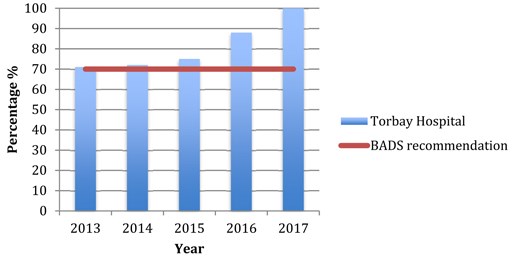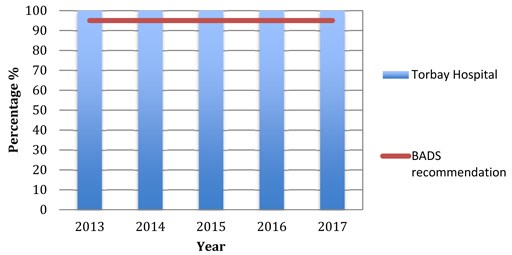Major Ear Surgery - are we meeting expectations? « Contents
Author:
Dr Natalie Smith Torbay and Southern Devon NHS Trust, Torbay Hospital, Torbay, United Kingdom
Dr Jane Montgomery, Consultant Aneasthetist, Torbay and Southern Devon NHS Trust, Torbay Hospital, Torbay, United Kingdom
Abstract
Introduction: The British Association of Day Surgery (BADS) has national recommendations for the percentage of operations which could be day case. Over the last 10 years the recommended rates for major ear surgery have increased. In 2007 suggested day surgery rate for mastoid surgery was 0% this is now 70%1. We audited our day surgery rates for major ear operations against current recommendations and assessed outcomes including post-operative pain, nausea scores, unplanned admissions and patient satisfaction.
Method: Using electronic record systems, we identified all patients who had primary tympanic, stapes and mastoid surgeries between January 2013 and July 2017.
Results: 202 patients underwent major ear surgery. We have been above the BADS recommended day surgery rates in all groups since 2014. There were 2 unplanned admissions, for pain and dizziness. Reports of mild post-operative pain were comparable across all procedures and years. Most patients had no post-operative nausea or dizziness. 6% of patients complained of mild post-operative nausea and only one patient reported moderate dizziness. All patients would recommend our unit, being satisfied or very satisfied with their experience.
Conclusion: We have demonstrated excellent outcomes for these patients and will continue to offer a day surgery pathway as the norm for the majority of patients.
Introduction
Torbay Hospital in Torbay and South Devon NHS Trust, has a purpose-built day surgery unit. The number of operations completed as day surgery is increasing, currently operating on over 9000 cases per annum (2). The British Association of Day Surgery (BADS) has national recommendations for the percentage of operations which could be day case. Over the last 10 years the recommended rates for major ear surgery have increased. In 2007 suggested day surgery rate for mastoid surgery was 0% this is now 70% (1). We wanted to know how we are doing against the BADS recommendation and how we compare to the rest of the country. We audited our day surgery rates for major ear operations, primary mastoid, tympanic and stapes procedures between January 2013 and July 2017. We also assessed secondary outcomes including post-operative pain, nausea scores, unplanned admissions and patient satisfaction.
Method
Patients were identified using Torbay Hospital’s electronic record system. This system is used to collect all individual data. All patients are telephoned on the first post operative day and answer a semi structured questionnaire about post operative symptoms and their satisfaction with our service. Using this electronic record all patients having primary major ear surgery between January 2013 and July 2017 could be identified. This group was divided according to their primary operative code for further analysis.
Our primary outcome measure was the day surgery rate for each procedure. The yearly rates were reviewed to assess for any improvement during the study period.
Secondary outcome measures of unexpected admission and post-operative complications were reviewed according to primary procedure and year of completion.
Article continues after ad.
Results
During the study period January 2013 to July 2017 our unit completed 83 primary tympanic procedures, 73 primary mastoid procedures and 46 primary stapedectomy procedures. A total of 202 primary major ear procedures.
Primary outcomes
BADS Directory of Procedures recommends the percentage of each operation that should be completed as day surgery (1). They also produce a table of how each the top 5%, 25% and 50% of hospitals are performing for each procedure (4).
BADS recommends that 70% of all primary mastoid surgery is completed as day surgery (1). During the study period we completed between 5 and 18 primary mastoid surgeries per year. Initially, in 2013 our hospital was completing 71% of cases as day surgery increasing to 100% in 2017.
Our hospital completes between 3 and 13 primary stapes surgeries every year. BADS recommends 90% to these to be completed as day surgery (1). Our hospital has been achieving this since 2014.
Completing all primary tympanic surgery as day surgery since 2013 our hospital is significantly better than the BADS recommendation of 95% as day surgery (1). Our hospital completed more than the recommended as day surgery despite the number of cases doubling per annum during the study period.
FIGURE 1: Percentage of Primary Mastoid Procedures completed as day surgery.

FIGURE 2: Percentage of Primary Tympanic Procedures completed as day surgery.

FIGURE 3: Percentage of Primary Stapes Procedures completed as day surgery.

Secondary outcomes
We were unable to contact 20% of patients on day one post operatively so can not report the secondary outcomes for these patients
Post operative complications such as nausea, dizziness and pain whilst usually innocuous can be very distressing for patients and affect their whole experience.
Nausea and vomiting is a complication that patients often worry about, with procedures on the ear increasing the patients’ risk. Postoperative nausea and vomiting was a rare complication, the numbers in this study are very small. We found that the vast majority of patients across all procedures reported no nausea or vomiting. No patient in the study reported severe symptoms. With the patients having Stapes or mastoid procedures no one complained of moderate symptoms with approximately one patient per year reporting mild symptoms. The patients having tympanic procedures had the highest reported severity of nausea with two cases experiencing moderate symptoms. These patients did not require admission.
Post-operative reports of pain varied between types of surgery. Mastoid and tympanic procedures reported more pain than patients having stapes procedures. Of the patients having stapes procedures a third reported mild pain but no one reported moderate or severe during the study period. Both tympanic and mastoid procedures have some cases which reported moderate pain, with one patient who had a mastoid procedure requiring admission.
Any patient having an operation on their inner ear is at risk of dizziness postoperatively. We found that mild dizziness following any major ear procedure was frequent but more severe symptoms were rare. In this study only one patient reported moderate dizziness following a mastoid procedure in 2014. This patient did not require admission.
Information is given to all of our patients on discharge on how to contact help if needed. They are given the units contact details as well as out of hours services. During the study period only one patient contracted the day surgery unit after discharge. This was for advice only and didn’t require any medical intervention.
Unexpected admission rates are important as it can highlight a problem with the service. We have had two unexpected admissions during this study. A stapedectomy patient was admitted due to dizziness and a mastoid patient for pain. Both patients were admitted in 2016.
Discussion
British Association of Day Surgery produce a dataset along side the directory of procedures. This shows the percentage of each of procedure being completed as day surgery by the top 5%, 25% and 50% of hospitals in the country (4). Using this data set we could review our own progress.
From the data 50% of hospitals are completing 27% or more of their primary mastoid procedure as day surgery and the top 5% completing over 85% as day surgery (4). Our hospital has shown significant improvement over the study period now being in the top 5% in the country. The top 5% of hospitals are completing 100% of primary stapes procedures as day surgery4, our hospital is in this group having completed all the cases as day surgery since 2015. Similarly the top 5% of hospitals are completing all of their primary tympanic procedures as day surgery. Like the other procedures our hospital is in the top 5%. Being in the top 5% nationally for all primary major ear procedures is a great success for our unit.
Acute postoperative pain is one of the most common forms of acute pain (3). Our hospital has guidance for peri-operative analgesia according to operation type. During the study we only had one patient admitted due to pain and only a few reporting moderate symptoms. This shows that the analgesia prescribed peri-operatively is suitable for the majority of patients.
As part of continuing improvement all patients are asked post discharge if they are satisfied with the service they received and whether they would recommend our day surgery unit. All patients in this study would recommend our day surgery unit. The patient satisfaction documentation support this will documentation says patients were either very satisfied or satisfied with our unit.
Our audit has shown that we were unable to contact 20% of our patients on day one post operatively. We are unsure why this is such a high percentage. Patients are contacted using the telephone number supplied by the patient pre-operatively. This system needs to be reviewed to reduce the number of uncontactable patients to ensure their safety and to allow completion of hospital journey paperwork for auditing.
Conclusion
We are meeting all of BADS recommendations for major ear procedure being completed as day surgery. Nationally we are in the top 5% of all hospitals for major primary mastoid, tympanic and stapes procedures. Although the numbers are too small for statistical analysis we can see that the occurrence of postoperative complications is low. We need to continuously review our service to maintain this high standard of care and meet the BADS recommendations.
References
- British Association of Day Surgery BADS Directory of Procedures 5th Published June 2016.
- torbayandsouthdevon.nhs.uk/services/day-surgery-unit
- Carr DB, Goudas LC, Acute pain, Lancet 1999:353;2051-8
- British Association of Day Surgery BADS Directory of Procedures National Dataset (Calendar Year 2015)
Cite this article as https://daysurgeryuk.net/en/resources/journal-of-one-day-surgery/?u=/2018-journal/jods-283-september-2018/major-ear-surgery-are-we-meeting-expectations
Download this article as PDF here: https://appconnect.daysurgeryuk.net/media/6008/smith.pdf
